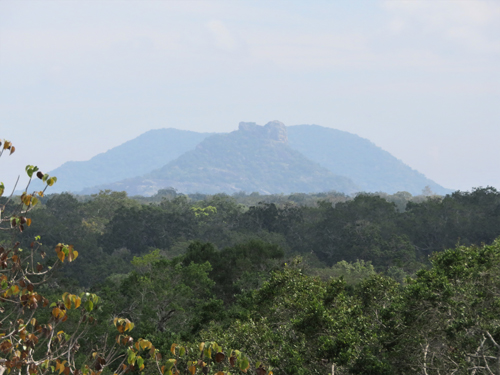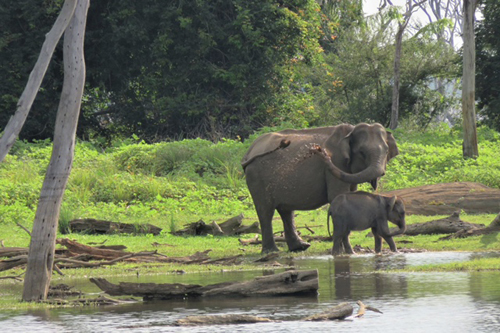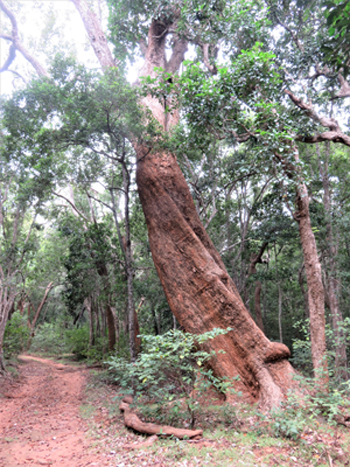Off the beaten track in Yala
 We felt the dry zone nip in the air as we transferred from our vehicle to the 50-year-old Land Rover Defender waiting for us at the Park gate at Galge.
We felt the dry zone nip in the air as we transferred from our vehicle to the 50-year-old Land Rover Defender waiting for us at the Park gate at Galge.
We had travelled on the expressway and passed a sleepy Sella Kataragama town by the time the day dawned for us at the Menik bridge. The river had a reasonable flow though the half-lit pink sky permitted only a ghostly view of it through the kumbuk thicket. The tree-lined road from Kataragama to Sella Kataragama also had a concrete line parallel to it on either side of which is the unplanned maze of accommodation and food outlets for pilgrims who throng the sacred city. The little hamlet that Sella Kataragama was 40 years ago is now an expanding township and the poor secondary road that ran from it to Buttala through the Yala National Park is now a virtual motorway. I remember how my parents in a group had walked the four-kilometre stretch from Kataragama to Sella Kataragama through the bush on a dirt track carrying us babies in the 60s. Times they are a-changing.
 After a 20 km drive from Sella Kataragama we reached the park gate at Galge on time. The gate lets you into Blocks 3 and 4 to the right and into the much visited 5, also called Veheragala (after the large reservoir found in it) to the left. Literally the inland landmass of blocks 3, 4 and 5 rest between the rivers Menik and Kumbukkan whilst the coastal strip is Block 2. The park office is a small insignificant building, but the authorities have added a decent row of visitors’ toilets in recent times. After attending to entry formalities, we entered Block 3 with the assigned tracker.
After a 20 km drive from Sella Kataragama we reached the park gate at Galge on time. The gate lets you into Blocks 3 and 4 to the right and into the much visited 5, also called Veheragala (after the large reservoir found in it) to the left. Literally the inland landmass of blocks 3, 4 and 5 rest between the rivers Menik and Kumbukkan whilst the coastal strip is Block 2. The park office is a small insignificant building, but the authorities have added a decent row of visitors’ toilets in recent times. After attending to entry formalities, we entered Block 3 with the assigned tracker.
Yala Blocks 3 and 4 are hardly visited except for Kebiliththa-bound pilgrims who toil hard on a rugged road to pay homage to the forest shrine by the Kumbukkan Oya, deep inside Block 3. This facility, which was not available to the pilgrims earlier, had been added in recent times to cater to an increasing demand we learned. The journey could be done in a 4-wheel drive vehicle only in dry weather between April and October. Our intention was to deviate to the right of that main Kebilththa track and reach the famous Varahana bridge of the Menik river in Block 1. We were excited as we knew how wild and beautiful the area could be.
It was pleasing to note the efforts of the Wildlife Department in restoring the two sizeable tanks in Malwariya and Thalakola as we drove on the respective bunds enjoying the sun on the waters encircled by breathtaking forest. Both tanks held a fair amount of rainwater to hopefully last till the northeast monsoon becomes active in November.
After a few kilometres we noticed the track wasn’t visible anymore due to the dense overgrowth.
 Alas! The track was covered with the ‘podisinghomaran’ (eupatorium odoratum) plant rising well over the bonnet of the jeep whilst ‘kappettiya’ (croton laccifer) branches crowded the rest of the visibility making it impossible to navigate. Also, the dry ‘podisinghomaran’ pollen disturbed by the moving vehicle invaded the air around, making us sneeze badly. After a while we realized we were now ankle-deep in fallen leaves and twigs inside the jeep. Thankfully we had reached one of the earmarked sites in Pilimagala by then. We halted and disembarked to commence the short walk across the vast rocky outcrop to its summit.
Alas! The track was covered with the ‘podisinghomaran’ (eupatorium odoratum) plant rising well over the bonnet of the jeep whilst ‘kappettiya’ (croton laccifer) branches crowded the rest of the visibility making it impossible to navigate. Also, the dry ‘podisinghomaran’ pollen disturbed by the moving vehicle invaded the air around, making us sneeze badly. After a while we realized we were now ankle-deep in fallen leaves and twigs inside the jeep. Thankfully we had reached one of the earmarked sites in Pilimagala by then. We halted and disembarked to commence the short walk across the vast rocky outcrop to its summit.
The site may have been used as a monastery during the Ruhunu Magama kingdom which flourished in the region from 3 BC to 10 AD. Pilimagala is one of many such sites in Yala belonging to that kingdom and from the summit we could see the famous Thalaguruhela rock in Block 3 at a distance. It is the peak on which the astonishing blue frangipanni is known to bloom once in a way but there is no accessibility as it is found deep inside the forest. So much so, a Rupavahini film crew recently doing a programme (soba dhara) inside the Yala National Park, got lost trying to locate Thalaguruhela and could reach it only on foot after spending a couple of nights on rocks fraught with danger.
 Our tracker was keen to show us a large drip-ledged cave where monks are said to have meditated but the path was totally shrouded in wilderness. The area was supposed to be infested with sloth bears. In fact, we saw how they had rooted in the soft earth after a light shower, looking for ground-ants.
Our tracker was keen to show us a large drip-ledged cave where monks are said to have meditated but the path was totally shrouded in wilderness. The area was supposed to be infested with sloth bears. In fact, we saw how they had rooted in the soft earth after a light shower, looking for ground-ants.
Since we couldn’t proceed beyond Pilimagala neither to Varahana nor Gal Amuna by the Menik river, we decided to cut across to Block 4. Blocks 3 and 4 don’t have many glades and as such are not conducive for animal watching but the forest looks untouched and thereby primordial. Once inside, one feels it is but a dry Sinharaja. The thick canopy and the dense undergrowth makes the air inside cool in addition to the shades of green so soothing to the eye.
Block 4, which is also known as Dambakote ara is full of hillocks. The canopy is much shadier, and the groves are much thicker but there appears to be more life than in Block 3 as we saw spotted deer, mouse deer and black naped hare darting across the track ahead followed by a nosy jackal or two. There were many birds of prey too perched low in thickets looking for any betraying movement beneath. It was obvious that the animals and birds of these two blocks are not used to vehicular movements.

Wild and beautiful: Less visited, Yala Blocks 3 and 4 present a different experience to the visitor
Our expedition ended at the Galge bungalow, picturesquely located overlooking a small tank, though its condition and design left much to be desired. We would have travelled further towards Maha Pilimigala if not for the same issue of the overgrown track.
The Wildlife Department would do well to maintain the network of tracks in Block 3 and 4 so that more people can visit. Since the vast Block 3 shares one border with the Yala Strict Nature Reserve (SNR), it is a treasure trove for botanists and students of forestry and environment in addition to wildlife. There are no campsites nor accommodation available in either block other than the old Galge bungalow.
We got to know of poaching too, mostly due to Sella Kataragama town growing in size and population, resulting in an illegal demand for bush meat. The only way to negate the threat is for the department staff to conduct regular night patrols. Another humble suggestion is to close the Sella Kataragama- Buttala road to the public from dusk to dawn. Since most of the fauna of Sri Lanka have nocturnal feeding habits such an action will save many lives. Within the last five years, scores of deer, jackal, hare, and a leopard had met with a sad fate due to speeding vehicles at night. All incidents have gone unrecorded except for the carcass reported on the side the next morning.
Yala is ranked among the best national parks in Asia. US$ 25 is the fee a tourist pays for single entry to the park so, it is up to the authorities to maintain the parks well including Blocks 3 and 4 as invaluable add-ons.
Lastly, it would serve both Lankans and foreign tourists if a panel of eminent architects – known for their eye for nature and wildlife – are appointed to design, build, restore and refurbish the park bungalows. They will be only too happy to offer their services free of charge as some did way back. Sadly, the new bungalows are not conducive to wildlife viewing nor are they built with purpose in rustic style to suit the remote and tranquil landscapes in which they are located.
Dusk fell as we left, tinting the forests in radiant orange and the three famed elephants who have got used to demanding food from passing vehicles were retreating into the jungle for their own safety!
Searching for an ideal partner? Find your soul mate on Hitad.lk, Sri Lanka's favourite marriage proposals page. With Hitad.lk matrimonial advertisements you have access to thousands of ads from potential suitors who are looking for someone just like you.


